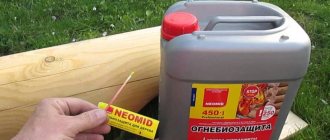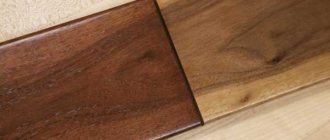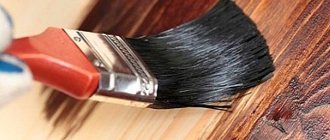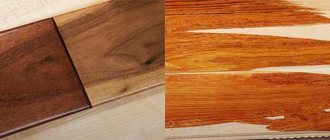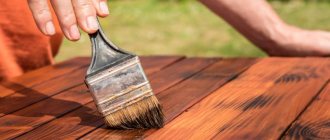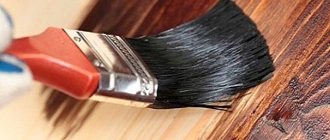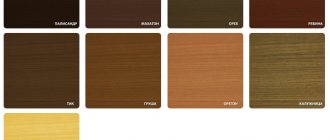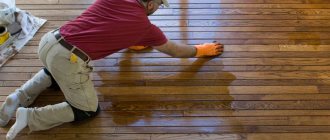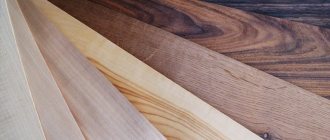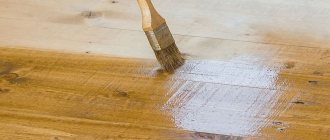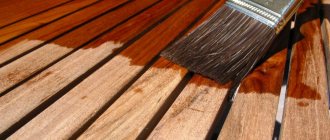To finish wooden products, in addition to paint, varnish or drying oil, a special substance can be used - stain (stain). It has a number of technical features. In our article we will learn about the best stain for wood - what it is, what technical features it has, and which liquid to give preference to when choosing.
Wood stain
Stain - what is it
Stain (stain) is a coloring composition for wood that enhances the natural color of wood and preserves its texture. Stain is usually used to paint furniture, small decorative items, doors or windows. It tolerates ultraviolet radiation well, so it can be used to cover surfaces both at home and outdoors. Beitz emphasizes and enhances the natural beauty of wood, and painted parts look stylish and aristocratic.
Attention! The composition is used only for impregnating wood - it is practically useless for other materials.
Why do you need stain?
In addition to its decorative function, stain also solves a number of other problems:
- Lightening/darkening wood.
- Protection from pests and mechanical deformation.
- Compaction of the material structure.
- Protecting wood from moisture and sunlight.
Difference from drying oil, paint, varnish
In terms of technical properties, drying oil, varnish and paint are similar to wood stain. However, there are a number of important differences between them - they are listed in the table:
| stain | Penetrates deeply into the wood, but does not close its pores, which allows you to preserve the natural pattern. Stain is used for self-finishing, with which you can restore the natural color and texture of wood |
| Drying oil | Penetrates weakly into the wood, but creates a thin, durable film on its surface. Drying oil performs a technical function - it prepares the wooden surface for further painting and varnishing |
| Varnish | It does not penetrate into the wood, but creates a super-strong film on its surface that protects against precipitation, mechanical deformation, and sunlight. The varnish performs primarily a technical function, but can create a pleasant shine on the surface |
| Dye | Does not penetrate into the wood, but creates a thin colored film on the surface. Paint is used for external finishing of surfaces (does not perform a protective function), and with its help you can completely hide the natural texture of wood by painting over it |
Table of differences
Stain is a paint or impregnation
The liquid substance with which a wooden product is impregnated and changes its shade is usually called stain.
- Interesting! This substance began to be called stain only recently; previously there was another name such as “beytsy”.
- Which is translated from German as dye. The solution could also be called “Cologne soil.”
- Because the first such substance was derived from humus, which was mined in the suburbs of Cologne.
- The brown color was the result of soaking the rotted substance in water. This stain has survived to the present day.
This composition, unlike paint, impregnates the upper layers of wood. If paints and varnishes give color to wooden products, hiding its entire structure.
Then, during impregnation with stain, peculiar transformations occur with the wood, which lead to a change in its shade, but the entire structure of the wooden product is not only preserved. But it also becomes very pronounced, i.e. The natural patterns of the wood are not changed.
For example, to convert alder into oak, a stain is applied to the product, which changes the shade of the wood. The market offers many varieties of this impregnation in natural color and with the addition of various dyes.
Which stain to choose?
Choosing a stain
When selecting a stain, focus on the following parameters:
- Composition type . If your budget is limited, water stain is suitable for tinting. But it is not recommended to use it in open spaces - use alcohol stain instead. If everything is fine with the budget, then it is recommended to use an oil or acrylic composition.
- Wood color . Typically, people use stain to age wood, making it look more aristocratic. For these purposes you need to buy a dark Benz. If you are working with dark wood, you can use a lightening stain.
- By method of sale . Stain is sold in powder or liquid form. The powder has a longer shelf life, but it must be prepared before use (fill with water or solvent depending on the type of stain). Liquid mixtures are ready for use, but they do not last long.
Wood stain video
Technique for highlighting wood patterns
The use of stain for tinting wood is often directly related to emphasizing its natural pattern. For this, a special technique is used, called brushing (from the English word “brush” - “brush”). By using this technology, you can not only highlight the design with color, but also give it a beautiful relief.
The technology is possible to implement due to the existing difference in the hardness of the wood layers. If you look at a cross section of a tree, you can see a pattern formed by annual rings, consisting of fibers with different strength characteristics. Their main difference is their different densities - among the hard layers there are softer ones that are easy to process.
An example of a wooden part that has been processed using the brushing method.
The natural relief appears when the top layer of soft wood fibers is removed, due to which it becomes decorative. The stain used in this method of transforming the material contributes to the color highlighting of the structural pattern.
To use this technique in combination with tinting, any type of wood with thick or thin longitudinal fibers is suitable. Wood structured in this way is used for the manufacture of furniture, flooring, paneling, as well as for the manufacture of individual elements of decorative finishing, for example, framing cladding made of other materials.
Brushing can be called the simplest and most affordable method of giving wood individuality and decorativeness, as well as, if necessary, artificially “aging” the material. In this case, the depth of the relief can be distinguished in different ways. For example, boards intended for flooring are not deeply processed, since dust and dirt will collect in the recesses. However, the pattern can be distinguished visually by using one or more stain solutions.
Brushed and stained boards.
It is quite possible to carry out the process of such wood decoration at home. This will require some simple hand tools and some common power tools.
Tools and devices that can be used to create structural relief on the surface of wood.
So, to give the tree a certain look, you need to prepare the following tools and materials:
- Wood stains for tinting, as well as brushes, rollers or spray guns. The tool is selected depending on the consistency of the tinting composition.
- Hand-held metal brushes of varying hardness, or a grinder (electric drill, screwdriver) with a metal brush attachment. These instruments are used to remove softer fibers.
- Sandpaper of different grain sizes - for rough cleaning and fine polishing of the relief.
- Varnish for the final coating of the finished product.
Sanding the board with a sander and a wire brush.
Everything is fine, but the master works with his bare hands. Don’t follow his example - don’t neglect your protective equipment! It should be noted that with a small sander at your disposal, the work can be done much faster, and the cleaning of the wood will be more uniform. This is due to the fact that the device operates at a constant speed.
For grinders, special narrow or wide brush attachments are provided, made of metal, polymers with an abrasive applied to it, as well as hair or sisal. By adhering to the step-by-step work, using such a power tool, you can make ideally decorated parts or blanks from wood for installing interior cladding.
The work is carried out in the following order:
Samples of blanks coated with a double layer of stain and brushed.
- If you plan to show the structural design in color, then the first step is to whiten the board or other wooden piece using one of the types of stain. After this, you should wait until the material dries completely - it should form a dense layer or completely saturate the wood several millimeters deep.
- A colored layer of stain is applied on top of the bleached workpiece so that it completely covers the primary one. The second layer of solution must also dry well, otherwise the wood will produce burrs during processing.
Classification of stain
On sale you can find compositions based on water, alcohol, oil, wax, and acrylic.
Water based
The composition is sold in the form of a powder for dilution with water or a prepared mixture that can be immediately applied to the surface. The material is cheap and sold at any hardware store. Water stain has good technical properties, but does not protect wood from moisture, so the composition is recommended for indoor use.
Advantages and disadvantages
Great for toning
Enhances natural color
Cheap and can be applied with a brush
takes a very long time to dry (up to 15 hours)
poor water resistance
Alcohol based
Sold in powder form for dilution with alcohol or solvent, as well as in the form of a finished liquid. Alcohol stains have good water resistance and dry very quickly (in 20-30 minutes), and for application it is recommended to use a spray gun.
Advantages and disadvantages
Excellent toning and saturation
Dries very quickly
High water resistance
the composition is highly toxic, so it is recommended to use it for treating wood outdoors.
Note! If the alcohol stain has dried out a little, add a few drops of solvent and shake the composition.
Oil based
It is a combination of natural and synthetic oils dissolved in drying oil or white spirit. It takes a very long time to dry (up to 48 hours), but has a pleasant color and provides high resistance to mechanical deformation, water, and light. An excellent choice for furniture and interior doors.
Advantages and disadvantages
Good aesthetic and technical characteristics
Complete environmental safety
Long shelf life.
very long drying
relatively high price
Wax based
An ultra-durable high-quality composition, which in terms of technical properties is more similar to varnish than to stain. After application, the wax weakly passes into the wood, but remains on the surface, creating a durable layer. Any products and entire buildings can be coated with a wax composition. However, the composition is very expensive, so it is usually used to finish products of cultural or historical value.
Advantages and disadvantages
Completely resistant to water and light
Can be coated on any surface.
Dries quickly (within 2-3 hours).
high price
the composition does not penetrate well into the wood
Based on acrylic resins
Another high-quality composition that is gradually conquering the domestic market. It is sold in the form of ready-made liquids that can be applied with a brush and spray gun, and the composition dries within 2-3 hours. A distinctive feature is a wide variety of colors and good technical properties.
Advantages and disadvantages
Good technical properties
High strength and water resistance
A lot of colors and shades
high price
Step-by-step dyeing technology
Despite the multiple preparatory steps, the direct process of applying stain is not at all complicated. It is performed according to the following scheme:
1. The stain is heated a little to increase the degree of penetration into the wood.
2. A swab, rag or brush is soaked in stain. Strong moisture should not be allowed, otherwise drips and uneven coloring will inevitably occur. When using a sprayer, pour the stain into the tank.
3. Apply stain along the wood fibers. They try to work quickly, without interruptions, to avoid stains. When streaks form, wipe the surface with a soft cloth, “pulling” excess liquid along the fibers. Leave the stain until completely dry.
4. In a similar way, apply several more layers to obtain the desired shade (usually 2-3 layers).
5. Finally, the stain-painted surface is varnished in several layers, sanding each intermediate layer with fine-grained sandpaper.
Features of choosing a stain
When choosing a composition for coating wood, it is necessary to take into account many subtleties - for example, the color of the stain, the technical properties of the wood, the cost of the composition, and others.
By color and shade
Selection by color and shade
There are several dozen shades of wood stain, but for convenience they can be divided into three categories:
- Darkening compounds. Shades of this group are used to artificially age wood. They give wooden products a noble, aristocratic look.
- Colorless compositions . They preserve the natural color of wood, but highlight its texture and highlight its beauty. Such compositions are suitable for finishing expensive wood species.
- Lightening compounds . They highlight the wood texture and also lighten the natural pattern. Lightening compounds are most often used to coat old wood, as well as dark types of wood.
Attention! To choose the optimal shade, it is recommended to paint a small piece of wood using stains of various colors.
According to the properties of wood
When choosing a composition, you must also take into account the technical properties of wood:
- Absorbing properties . Coniferous wood species are less saturated with stains because they contain a lot of resins. But hardwood does not contain such resins, so it is easier to impregnate them with stain.
- Density of wood . Wood with low density quickly absorbs the composition, so it needs to be painted in 2-3 passes after the previous layer has completely dried.
- Wood texture . If you want to emphasize the natural texture of wood, then use stains of dark shades. You can also use several compositions of similar shades at once.
By purpose
When selecting a stain, you need to take into account the purpose of the wood structure:
- If the product or structure will be located outdoors, it is recommended to give preference to acrylic, oil or wax stains. They do not let water through and do not fade in the sun. Structures and products inside the house can be painted with an inexpensive water-based stain.
- Also consider the toxicity of the compounds. If you are working indoors, it is recommended to avoid alcohol stains - they dry quickly, but leave an extremely unpleasant odor. But acrylic, oil or water-based compositions are ideal (although they take longer to dry).
By application method
When choosing an impregnation, keep in mind the application rules:
- Water stain can be applied in any way - with a roller, spray gun, foam rubber, or using a brush with natural or synthetic bristles.
- Alcohol compositions are applied exclusively with a spray gun, since the composition sets very quickly and has a characteristic unpleasant odor.
- Oil, acrylic and wax stains are recommended to be applied with a brush with natural bristles or a foam sponge.
By price
The cost of stains on the domestic market ranges from 50 to 1000 rubles per jar with the composition. The cheapest compositions are water and alcohol stains, the price of which rarely exceeds 100 rubles. Then there are oil fluids, which cost 100-200 rubles. The most expensive stains are acrylic and wax liquids, the price of which can reach up to 1000 rubles.
Attention! Beitz is usually sold in containers of 0.4, 0.8, 1, 2 and 10 liters (liquid in bottles and tanks, dry in plastic boxes).
Water stain for wood - advantages and disadvantages
There are two types of water stain - for exterior and interior use. However, you need to understand that to protect the wood that is the exterior of the house, stain alone is not enough. In order for the wooden exterior of a house to serve for a long time and be pleasing to the eye, it needs a whole range of protective coatings and impregnations.
The main advantages of water-based wood stains are the following.
- Low cost.
- Environmentally friendly, no harmful effects on the body during operation.
- Working with the described stain is simple and accessible even to non-professionals.
- Water-based stain has excellent adhesion to wood.
- A huge range of all possible shades.
Among the disadvantages is the already mentioned long drying time - up to fourteen hours. And also the fact that for outdoor work, in addition to stain, other products will be required. As for internal work, you need to look at the circumstances.
Review of the best compositions
Now let's look at the TOP 10 best formulations presented on the Russian market.
Profilux
Profilux stain
is an alcohol-based stain with moderate consumption (120-150 ml per 1 square meter). The liquid is sold in several colors, has good technical properties and dries quickly. The main disadvantage is that it has an unpleasant odor, so it is recommended to use it outdoors.
Vixen
Wood stain Vixen
Liquid is made on the basis of alkyd and natural resins, which ensures good technical properties of the stain and complete environmental safety. Vixen sets very quickly (in 20-30 minutes), but has a high consumption (200-2500 ml per 1 square). Therefore, the composition is recommended for use for finishing furniture.
KolerPark
Universal KolerPark
Universal acrylic stain, characterized by low consumption (100 ml per square), completely resistant to water and sunlight. The liquid has a lot of colors and shades, which allows you to choose the optimal liquid for your tree. A universal stain for household needs - from tinting doors to restoring antique toys.
NOVBYTHIM
Alcohol liquid NOBBYTHIM
Another alcohol liquid that enjoys well-deserved popularity among Russian craftsmen. Thanks to additives, the liquid is characterized by reduced toxicity, and if necessary, such stain can be washed off with a solvent. It has low consumption (up to 100 ml per square meter) and good water-repellent properties.
TIKKURILA
Cheap water stain TIKKURILA
Cheap water stain, which is useful for finishing furniture and wooden surfaces inside the house. It has good stability and low consumption, dries quickly, and does not deteriorate for a long time during storage. The stain has many colors and shades, which will allow you to choose the liquid for the needs of the master. A good choice for finishing a cottage and inexpensive furniture.
Minwax
Quality Minwax
A demanding but quality oil-based stain. The oil tolerates exposure to sunlight and water well, and stains based on it are suitable for any type of wood. The composition takes a long time to dry, and at least 10 hours should pass between applying layers. Minwax is an excellent choice for finishing expensive furniture and wooden houses.
Attention! When choosing, look at the date of manufacture - recently there have been more and more cases of Minwax oil sealant being sold with an expired expiration date.
"Smart repair"
Cheap “Smart Repair”
Cheap water stain, which thanks to additives dries very quickly (you can start applying a new layer after 1 hour). It is not friendly with water and sunlight, so it is recommended to paint furniture, doors, and thresholds inside the house with stain. Another characteristic feature: moderate consumption - only 100 ml per 1 square.
KRAFOR
Quick-drying stain KRAFOR
Quick-drying alkyd stain, adapted for hardwood. It dries within 10-20 minutes, so the composition is ideal for quick application. It has a relatively high consumption (120-150 ml per 1 square) and is expensive, so it is recommended to buy it for finishing furniture and external surfaces of the house.
LIBERON
Universal LIBERON
Universal acrylic stain for all types of wood. It is also distinguished by relatively high consumption (up to 160 ml per 1 square), but good technical properties - excellent water resistance, complete resistance to light, a variety of shades. A good choice for painting any surface - from furniture to the exterior of the home.
Latek
Economical Latek
An economical, cheap, water-based stain that takes a long time to dry, but has good resistance to water and light. It is characterized by low consumption (80 ml per 1 square meter), sold in the form of powder and ready-made liquid. An excellent choice for exterior decoration of cottages and country houses, as well as for decorating old furniture.
How long does it take to dry?
Each type of stain has different drying times , which are indicated on the packaging or in the instructions for the selected composition.
- When applied to a surface, water stains dry from 12 to 20 hours;
- alcohol compositions dry quickly, up to 5-7 minutes. In low temperature or high humidity conditions, drying time may be 30 minutes;
- oil impregnations dry in 1 to 2 days after application;
- acrylic compositions dry within 60 minutes;
- Wax stains dry for 12-14 hours after application.
How to make stain with your own hands?
How to make stain with your own hands?
You can prepare something like a stain at home with your own hands. Several recipes:
- For a brown shade . Grind the walnut shell into powder, put it in water, boil the powder for 10-20 minutes, strain the resulting coloring solution through a sieve and cool.
- For a reddish-brown shade . Take 200-300 g of onion peel, boil it in 1 liter of water, strain the solution through a sieve and cool.
- To lighten wood . Mix a 40% hydrogen peroxide solution and a 30% ammonia solution in a ratio of 9 to 1, mix the resulting mixture thoroughly.
Non-aqueous stain: color range
Manufacturers produce several options for filling protective mixtures.
These are the following types:
- Transparent stains. Used to create a protective film on the surface of wood. In addition, transparent mixtures perfectly highlight the structure of the wood, give the product a well-groomed appearance, tint and protect.
- Colored compositions. This type of stain can be used for design purposes, giving the wood unusual shades, and turning ordinary pine into stained oak.
Non-standard, bright color shades are also produced: emerald, pearl, various tones of the now fashionable gray color in design.
The palette of shades is quite diverse, with imitation of valuable wood species. Manufacturers produce colored stains like oak, ebony, rosewood, walnut, mahogany, wenge and others.
Work technology
Let's now find out how to work with stain in practice.
How to apply stain
Beitz is recommended to be applied to clean wood. If there is a layer of paint or varnish on the wood, you need to get rid of it in the following ways:
- To remove old varnish, special chemical removers are used. Buy this composition at any hardware store, prepare and apply it according to the instructions.
- To get rid of a thick layer of old paint, you need to coat it with solvent and then cover the surface with cellophane. The next day you need to scrape off the soaked paint with a spatula, sandpaper or sander.
- In the case of a thin layer of paint or varnish, you can use acetone solvent. Saturate a rag with it, wet the surface, wait 5-10 minutes, and then remove the varnish or paint with a spatula.
Finishing work rules
Applying stain in general is very similar to conventional staining:
- If you apply stain to bare wood. Using a brush or spray gun, carefully apply the composition over the entire surface. When it dries (shelf life depends on the type of stain), reapply another coat of stain in a thicker layer.
- If you apply stain to stain . You can also use a brush or spray gun to re-tint. However, you only need to apply one additional coat (note, however, that it should be thick enough to cover the old stain).
Dealing with defects
If applied incorrectly, streaks and stains may appear. Let's find out how to deal with them:
- Streaks . If you notice a leak immediately after application, apply a layer of varnish over the stain. As a result, the varnish will dissolve the stain, and the mixture will turn into a thick liquid - remove it with a rag. If a leak is discovered after drying, then do exactly the same work, only use white spirit instead of varnish.
- Spots . You need to work on the same principle as with streaks - remove the stain using varnish or white spirit, apply a new layer of stain. If the stain layer is thick enough, the stain can also be removed using a plane with a well-sharpened blade.
How to remove stain
How to wash off stain
Water stain can usually be washed off with tap water. But the rest of the compositions are quite stable, so they can only be washed off with a good solvent or white spirit. Grouting must be done carefully, since the solvent will wash away both the stain and the “native” dyes. If the composition gets on clothing, it is better to throw it away, since washing will be ineffective.
How to use
Important! Before applying impregnation, you must carefully familiarize yourself not only with the wood, but also with the composition of the stain that will be used during the work.
Impregnation is applied in the following ways:
- By rubbing the stain. For work, soft cloth or foam rubber is used. This gives the effect of a pronounced wood color, which is achieved by staining for loose wood or an overdried product;
- By spraying the solution. During the work, a spray gun is used, which gives the wood a rich shade. Therefore, the color of the stain is selected a little lighter than the required option;
- By pouring. The solution is applied with a brush to a wooden canvas or product. And wait about 20 minutes until the stain is absorbed. Then remove the unabsorbed layer with a clean cloth. One thing is important here: the longer the solution stays on the object, the brighter its shade will be;
- Using a brush. Traditional brushes of the required sizes are used. The color of the product depends on the number of layers applied to the surface of the object.
Useful tips
Let's look at some important tips:
- Do not apply the composition in the cold. Stain adheres very poorly to a wooden surface at low temperatures, so you will get uneven toning.
- If you are working with coniferous wood , then after removing the old paint/varnish you need to deresin the wood. Mix 100 g of acetone and 400 g of water, cover the surface of the wood with the mixture, rinse it off after 30 minutes and dry the wood.
- If you want to get a light cherry color of wood , then instead of stain you can use potassium permanganate for impregnation. Dissolve 50 g of potassium permanganate in 1 liter of water, saturate the wood with the mixture in 2 approaches.
In conclusion, I would like to note that when choosing a stain, you should not skimp. People usually buy cheap water-based compounds, but they need to remember that they are only suitable for finishing wood inside the house. If you want to tint outdoor wood structures or expensive items, be sure to buy acrylic, oil or wax stain. Let you pay an additional 600-700 rubles, but the effect of tinting will last for many years.
Wood stain video
Surface treatment before work
Before applying stain, the wood surface must be prepared. They do this in stages:
1. Remove the old coating (if any). To do this, scrape and polish the boards. In addition to removing the old coating, these procedures will level the floor surface.
2. Clean the surface from grease and oil stains by wiping problem areas with a rag soaked in white spirit or gasoline.
3. It is advisable to deresin coniferous species before applying stain. That is, remove resin from the wood structure, which can interfere with the absorption of the stain. Solutions for degumming are prepared according to the following “recipes”:
- 50 g of potassium carbonate and 60 g of soda ash are dissolved in 1 liter of water heated to 60˚C.
- Dissolve 50 g of caustic soda in 1 liter of warm (soft) water. Treat the surface with the resulting 5% soda solution.
- Mix 750 ml of distilled water with 250 g of acetone.
Any of these solutions is generously applied to the boards, preferably in several layers. After half an hour, wipe the surface with a cotton cloth and rinse with warm water.
